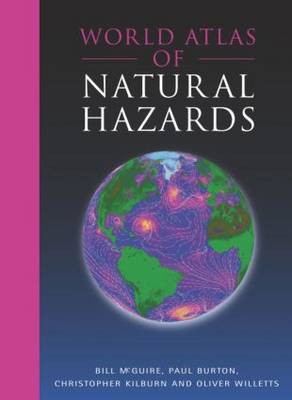World Atlases
1 total work
WORLD ATLAS OF NATURAL HAZARDS
by Christopher J. Kilburn, Paul Burton, Ollie Willetts, and W.J. McGuire
Published 27 August 2004
In the opening year of the new millennium, an astonishing one in every thirty people on the planet were affected by floods, storms, earthquakes, volcanic eruptions and other natural phenomena. Rapid-onset geophysical hazards (natural hazards or geohazards) have always exacted a devastating toll on society, both in terms of damage to property and infrastructure and loss of life. During the last millennium it is estimated that over 12 million deaths resulted from over one hundred thousand natural catastrophes triggered by geohazards. In the 20th century alone, the numbers of lives lost may be as high as 3.5 million, and there is little sign, at present, of the situation improving. In fact, the last three decades have seen a dramatic and worrying escalation, both in the numbers of natural catastrophes caused by geohazards, and in the accompanying economic and insured losses. This is partly due to the increasing concentration of both people and wealth in regions of high vulnerability, but the situation is exacerbated by extreme events associated with climate change and by direct human action such as deforestation and urbanisation.
The World Atlas of Natural Hazards presents an authoritative yet accessible picture of the perils our planet and our society currently face and a view of the range and scale of threats that may be expected in the new century and beyond. The atlas incorporates a narrative that is driven by maps, images and graphics to paint portraits of natural hazards in space and time, the manner in which they impinge upon our society, and what we can do to avoid, mitigate, or manage their worst excesses. New research that sheds light on processes and mechanisms is addressed, along with established and innovative methodologies designed to limit the impact of natural hazards and reduce associated risk. The book opens with an introduction to the historical development of hazard and risk mapping and closes with a sober assessment of prospects for the future.
The World Atlas of Natural Hazards presents an authoritative yet accessible picture of the perils our planet and our society currently face and a view of the range and scale of threats that may be expected in the new century and beyond. The atlas incorporates a narrative that is driven by maps, images and graphics to paint portraits of natural hazards in space and time, the manner in which they impinge upon our society, and what we can do to avoid, mitigate, or manage their worst excesses. New research that sheds light on processes and mechanisms is addressed, along with established and innovative methodologies designed to limit the impact of natural hazards and reduce associated risk. The book opens with an introduction to the historical development of hazard and risk mapping and closes with a sober assessment of prospects for the future.
